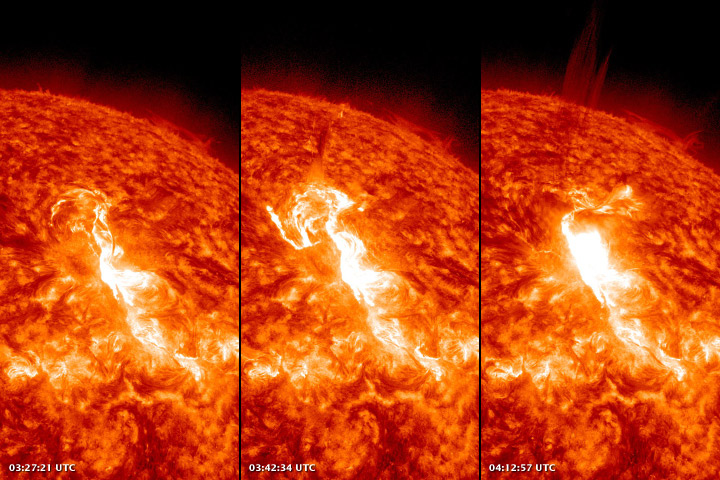File:The Sun Flares with Activity.jpg
The_Sun_Flares_with_Activity.jpg (720 × 480 pixels, file size: 158 KB, MIME type: image/jpeg)
Captions
Captions
| DescriptionThe Sun Flares with Activity.jpg |
To download the full resolution and other files go to: [1] Following one of the longest and weakest periods of activity in many cycles, the Sun is brimming with activity again. In late January 2012, our nearest star offered a preview of what may be to come in the solar maximum of 2012–13. The storm has the potential to disrupt some communications and satellite systems and to bring auroras to high-latitude skies. The images above show a solar flare as observed by the Atmospheric Imaging Assembly (AIA) on NASA’s Solar Dynamics Observatory (SDO) at 03:27, 03:42, and 04:12 Universal Time (Greenwich Time) on January 23. Note the brightening of the solar surface as gas was superheated and magnetically supercharged. By the third (right) image, a stream of solar material is seen flowing off into space above the hot spot, likely solar protons and a coronal mass ejection. The high-latitude solar flare was measured as M8.7 in intensity, just below the most intense “X class” of flares. The eruption sent a stream of fast-moving, highly energetic protons toward Earth, provoking the most intense solar energetic particle storm—an S3 on NOAA Space Weather Prediction Center’s scale—since 2005. The flare was accompanied by a coronal mass ejection (CME), a cloud of solar plasma that was ejected from the solar atmosphere in the direction of Earth. The CME was observed by the STEREO and SOHO spacecraft with an initial speed of more than 2,000 kilometers (1,400 miles) per second. It was estimated to reach Earth sometime on January 24 and Mars on January 25. NOAA forecasters were predicting a G2 geomagnetic storm, though a G3 was possible. Solar flares and CMEs are not a danger to humans on Earth's surface, as the planet's magnetic field (magnetosphere) and atmosphere deflect and absorb the solar energy and particles. The sun storms can pose some risks to astronauts, and they can upset the electronics and transmissions on science, military, and communications satellites. Closer to Earth's surface, solar activity can cause disruptions of radio signals (particularly HF), provide a small dose of radiation to passengers on high-latitude flights, and provoke auroras (northern and southern lights). The storm is impressive by recent standards, but nowhere near the maximum intensities often generated at the height of the solar cycle. “I would expect that we will see more storms like this one or even bigger as we get closer to solar maximum,” said Michael Hesse, chief of heliophysics at NASA’s Goddard Space Flight Center. NASA images courtesy Solar Dynamics Observatory. Caption by Mike Carlowicz. |
||
| Date | |||
| Source | Flickr: The Sun Flares with Activity | ||
| Author | NASA's Earth Observatory | ||
| Permission (Reusing this file) |
This file is licensed under the Creative Commons Attribution 2.0 Generic license.
|
Solar activity
File history
Click on a date/time to view the file as it appeared at that time.
| Date/Time | Thumbnail | Dimensions | User | Comment | |
|---|---|---|---|---|---|
| current | 20:57, 24 January 2012 |  | 720 × 480 (158 KB) | Flickr upload bot (talk | contribs) | Uploaded from http://flickr.com/photo/68824346@N02/6755328229 using Flickr upload bot |
You cannot overwrite this file.
File usage on Commons
There are no pages that use this file.
File usage on other wikis
The following other wikis use this file:
- Usage on ru.wikinews.org
